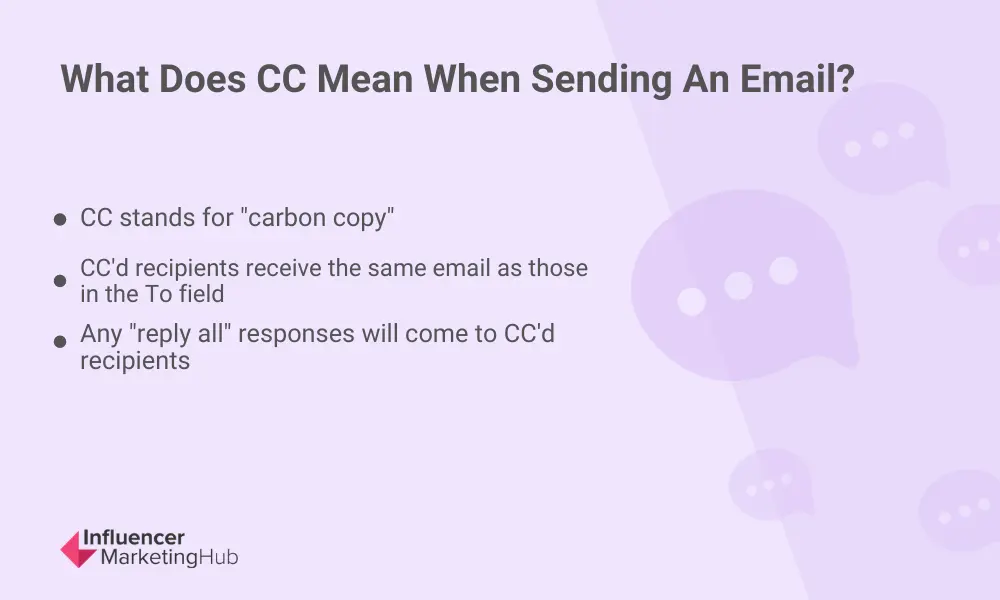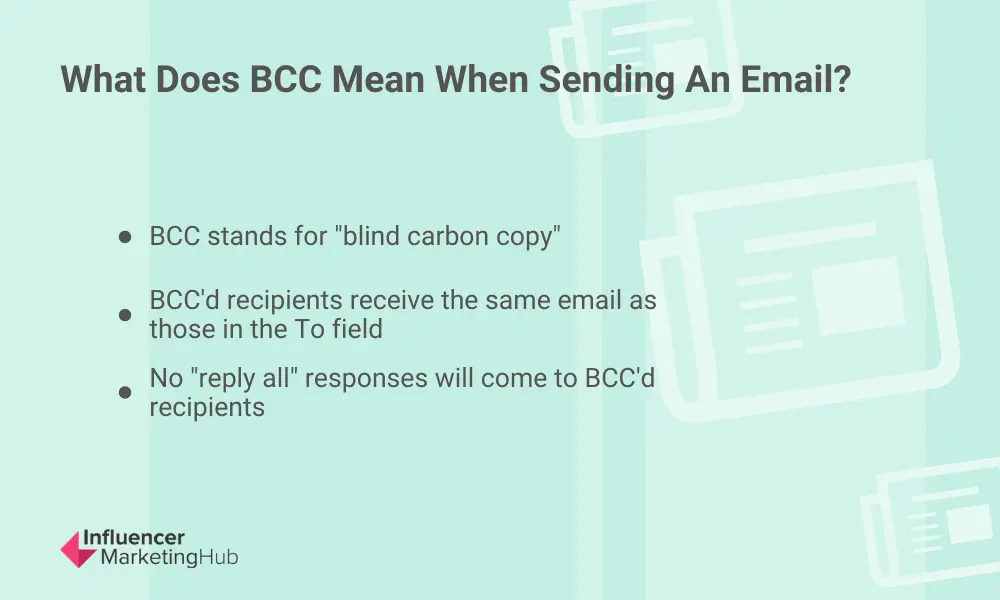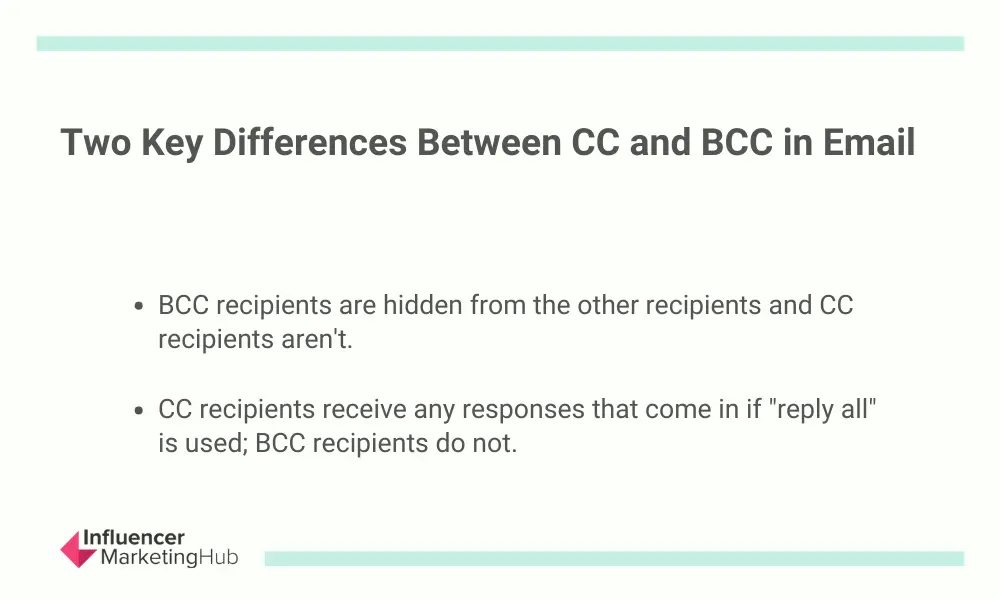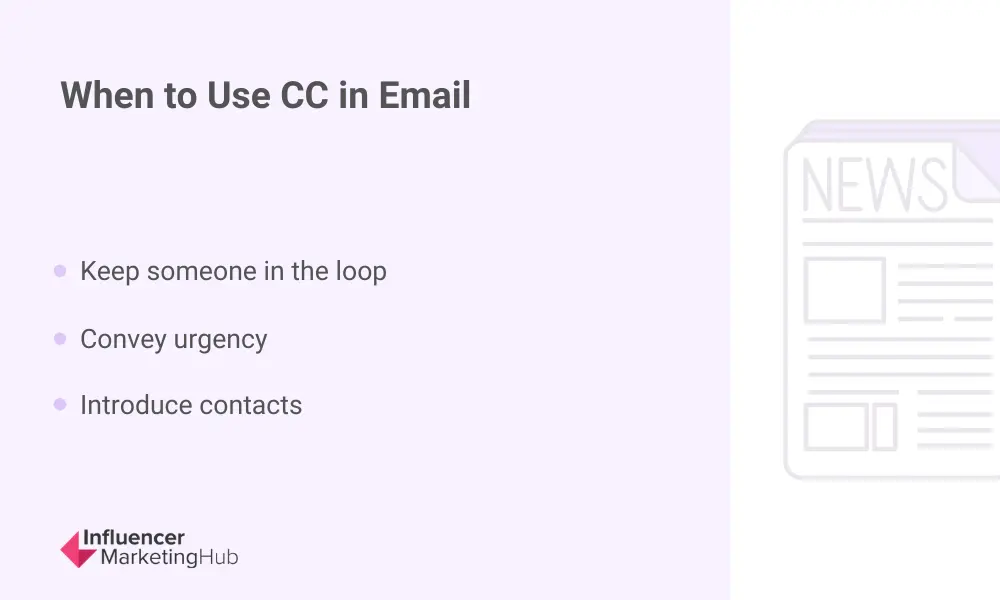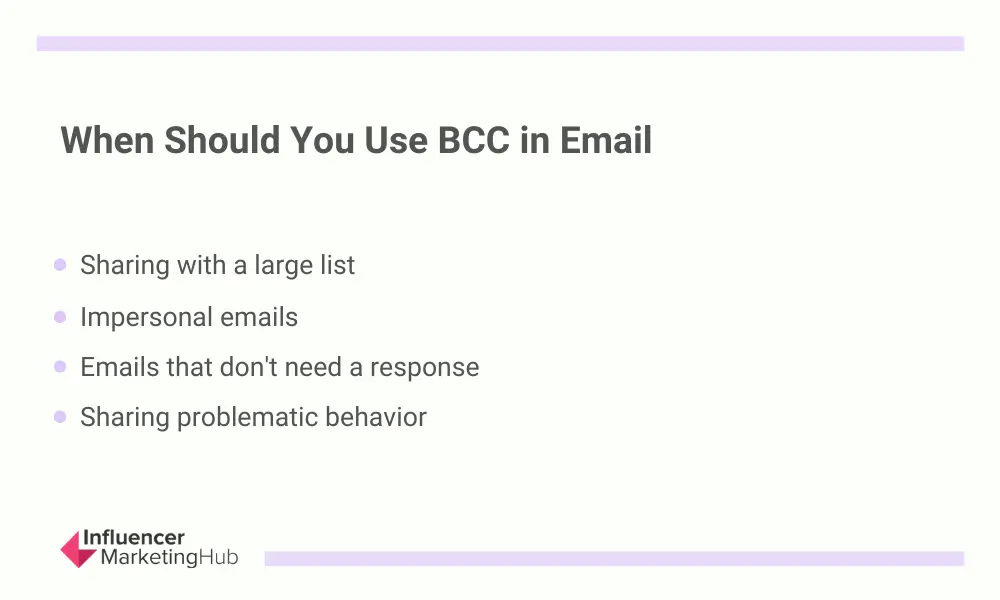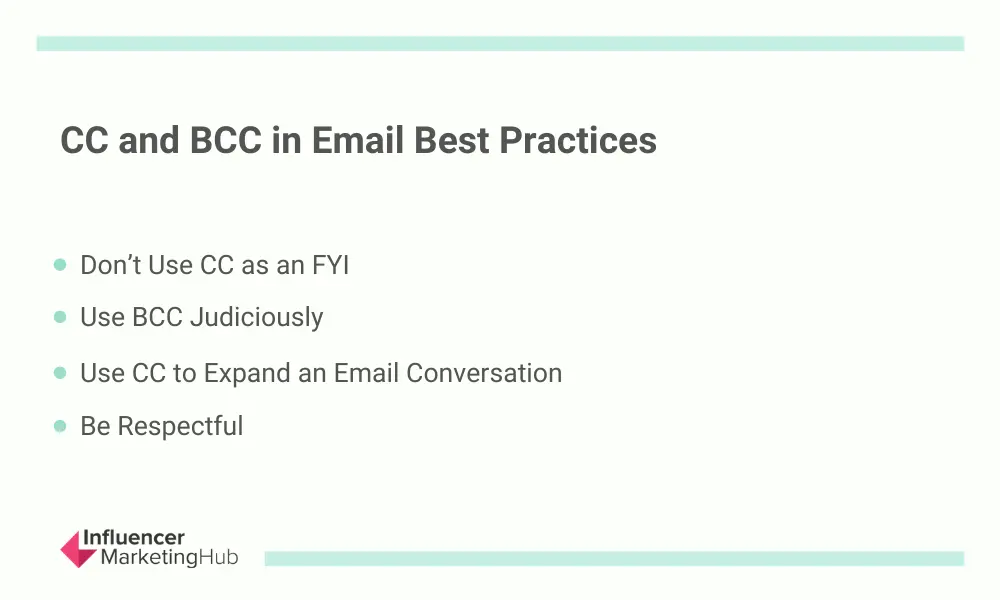If you’re confused about CC and BCC in email, this is the article for you! We’ll you give you an overview of what each means when you’re sending emails, the difference between CC and BCC in email, when you should use each, and four CC and BCC in email best practices you can use to ensure you’re not setting yourself up for awkward email conversations.
How to Use CC and BCC in Email to Keep Communications Efficient:
What Does CC Mean When Sending An Email?
CC stands for “carbon copy” which means that recipients in the CC field get the same email message as those in the To field and any “reply all” responses will come to them. Everyone included in the email will be able to see who is CC’d on it.
If you’re a stickler for email etiquette, only the main recipients of the email should be in the To field. That’s because those recipients are more likely to be impacted by the email’s content and expected to take action in some way. CC recipients, however, tend to be secondary recipients, meaning they are CC’d on the email to keep them informed of what’s going on. These recipients aren’t necessarily required to respond or take action.
A good example of CC usage would be if you’re requesting a change from someone in one department that will impact someone in another department. You’d want to put the person responsible for taking action (making the change) in the To field while the CC field would be reserved for the person who will be impacted by the change but isn’t necessarily being asked to do anything.
What Does BCC Mean When Sending An Email?
BCC in email stands for “blind carbon copy.” As the term suggests, BCC recipients receive the same email as those in the To and CC fields. The difference is that they don’t get responses from the email and other recipients don’t see who is BCC’d. BCC is typically used for mass emails since it hides recipients’ email addresses, protecting their privacy from other recipients.
What Is the Difference Between CC and BCC in Email?
We’ve touched on some of the differences between CC and BCC in email just through our descriptions of the two terms but let’s take the time to get a little deeper. First, both the CC list and BCC list allow all recipients on an email get access to the same email. The main difference between the two is that BCC recipients are hidden from the other recipients on the email and CC recipients aren’t. So, CC recipients show up to everyone and BCC recipients show up to no one.
CC’d recipients will also have access to any responses that come in for the email if the “reply all” response is used. BCC’d recipients don’t get those additional emails as responses come in so will only be aware of replies if those specific replies are forwarded to them.
If you want to use CC and BCC in email effectively, you’ll want to keep in mind how the fields work. Despite the outdated terminology (does anyone know what a “carbon copy” or “carbon paper” is these days?), the fields themselves work in a straightforward manner. If it makes it easier, just drop the word “carbon” and think of CC as “courtesy copy” and BCC as “blind courtesy copy.” Then, move on from there.
Entering an email address in the CC field means that the email will be copied to that recipient. That means that they’ll get the same email as everyone else. The recipients in the To field and CC field are open and viewable to everyone. BCC recipients, on the other hand, aren’t visible to anyone else, though they will also receive the same email as everyone else. Since they’re only included on that specific email, they won’t get any of the replies to that email. Essentially, BCC only applies to the email on which those BCC recipients were entered.
As you can probably see, the main difference between CC and BCC in email is the privacy afforded to the recipients.
When Should You Use CC in Email?
So, if the CC field and To field work exactly the same, the email is delivered to the recipients just the same, everyone in those fields can see the others in those fields, they all get the replies, and it doesn’t make any difference if you add someone to the To field or the CC field, why would you use the CC field for your emails?
It’s really all about email etiquette and helping the recipients understand what’s expected of them. So, if you’re adding recipients to the To field of your email, those are the recipients for whom the email is explicitly intended. These are the people who need to respond or act in some way. The CC field, then, is used for recipients who need to be kept in the loop regarding the email’s content. This means that while the content is important to those in the CC field, there’s no action or response required of those recipients.
Here’s a quick list of when to use CC in email:
- Keep someone in the loop: keep someone updated on info that doesn’t require their immediate, direct response or action
- Convey an email’s urgency: CCing higher-level employees in your organization signals the recipients in the To field that the content of the email is important
- Introduce contacts: use CC to share the email addresses of the people you’re introducing so they can talk directly
As you can probably imagine, CCing recipients can lead to cluttered up inboxes. We’ll be talking more about how to combat this in our CC and BCC in email best practices in a moment.
When Should You Use BCC in Email?
The BCC list has several use cases. Since the email addresses included in the BCC field are private there are several ways you can use BCC in email to make sure your needs, and the needs of your recipients, are met.
For starters, you can use BCC in email to keep someone updated about what’s going on in a situation without letting everyone else know. This is a great way to keep a supervisor informed about what’s going on with a specific employee without worrying the employee by including the supervisor in the To or CC fields. You can also use the BCC list if you want to keep a copy of an email in an alternative email address without sharing that email address with everyone on the email.
There are also times you may want to send an email to many people but don’t want to share everyone’s email address with everyone else on the email. In those cases, you can add your own email address in the To field and include all of the other email addresses in the BCC email field.
Here’s a quick summary of when to use BCC in email:
- Sharing a company newsletter or using a large mailing list: keep recipients private when you’re sending an email newsletter or informational email to a list of people—especially if your recipients don’t know one another
- Impersonal emails not requiring a response: if you’re sending an announcement or something that is impersonal, BCC is a great option
- Sharing problematic behavior: sometimes you might want to share an email with another party that should be aware of what’s being said in the email
As you can see, BCC in email is a great way to maintain the privacy of your email recipients. There are also some reasons you wouldn’t want to use BCC in email. If you’re sending an email introduction, for instance, you’ll want to include both recipients in the To field. If you’re responding to such an introduction, however, you can move the person doing the introduction to the BCC field so they know that you’ve replied to the introduction but don’t get bogged down with all of the replies.
CC and BCC in Email Best Practices
By now, you should have a really good idea of how CC and BCC in email work to keep your email communications clear and effective. However, it’s easy to misuse these tools. In this section, we’re going to talk about CC and BCC in email best practices that will make your email clearer and more efficient without getting you into hot water.
1. Don’t Use CC as an FYI
The CC field lets you include anyone in your emails and much of the time, CC is used to keep people “in the loop.” However, this usage of CC can create cluttered inboxes and serve the opposite purpose if those CC’d start getting inundated with replies that they don’t need. To mitigate this, you can add all recipients in the To field along with an explanation of why you’re sending the email and stressing that no action or response is necessary.
If a response or action is necessary from some recipients, you’re going to want to distinguish those recipients by adding them to the To field and including the other recipients in the CC field. You should still include something in the body of your email indicating who you’re CCing on the email, why, and letting those CC’d know that they don’t have any action to take.
Important Note: If you use an email marketing service that charges you per email sent, those CC’d recipients count towards your total. That means you’re getting charged for every person included as a CC in your emails. Something to think about.
2. Use BCC Judiciously
BCC is a tricky feature and should be used carefully. It’s a great email feature to help protect the privacy of your recipients, but it’s also very easily misused. Plus, you could even break privacy laws if you use it incorrectly.
There are several privacy laws now in place like GDPR in the EU, PIPEDA in Canada, CCPA in California, and others. These privacy laws include explicit details about how you can collect, store, and share personal data like email addresses. Use of CC and BCC in email can both be interpreted as sharing recipient email addresses without the consent of the people in the To field, and that can get you in trouble if you’re subject to certain privacy laws.
3. Use CC to Expand an Email Conversation
One of the best uses of the CC field in email is to expand an email discussion to include others who can contribute to the conversation in some positive way. If you’re the original sender of the email, you should absolutely request permission to add new recipients from the others already on the email. Asking for permission can keep you out of trouble with those privacy laws we just talked about.
4. Be Respectful
This applies to both CC and BCC in email. No matter what you’re doing with your email and recipients, be respectful. This means not sending unnecessary emails, not overloading the recipients list and clogging up inboxes, and not sharing personal data and personal conversations with others without their consent.
TL; DR for CC and BCC in Email
Now that you’re more familiar with the similarities and differences between CC and BCC in email, you can create emails using proper email etiquette to keep all recipients happen and your emails professional.
In a nutshell, CC lets all recipients see the list of recipients and their email addresses as well as getting all responses to the email. BCC recipients are hidden from each other and the other recipients and won’t be sent responses.
As an added bonus, a quick note about “reply all:” in most cases, don’t.

